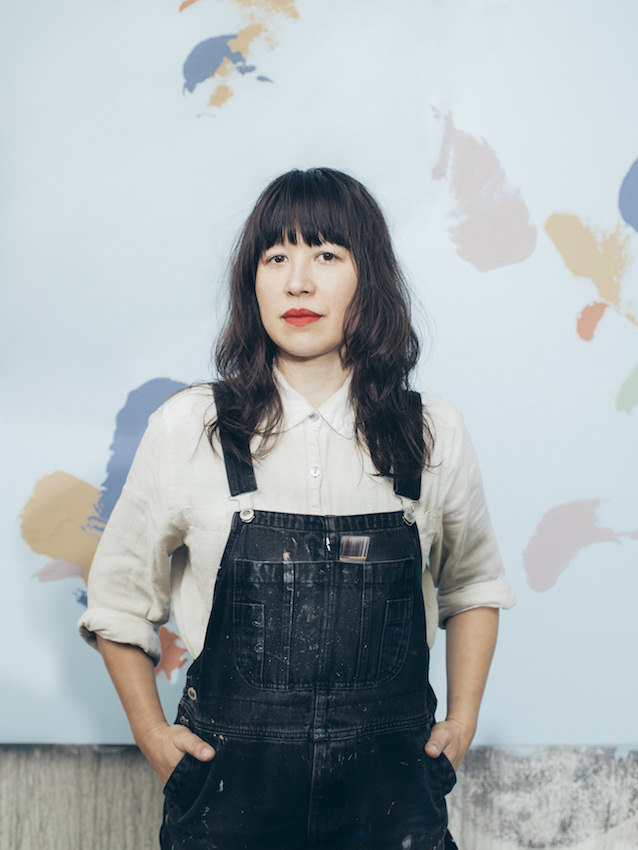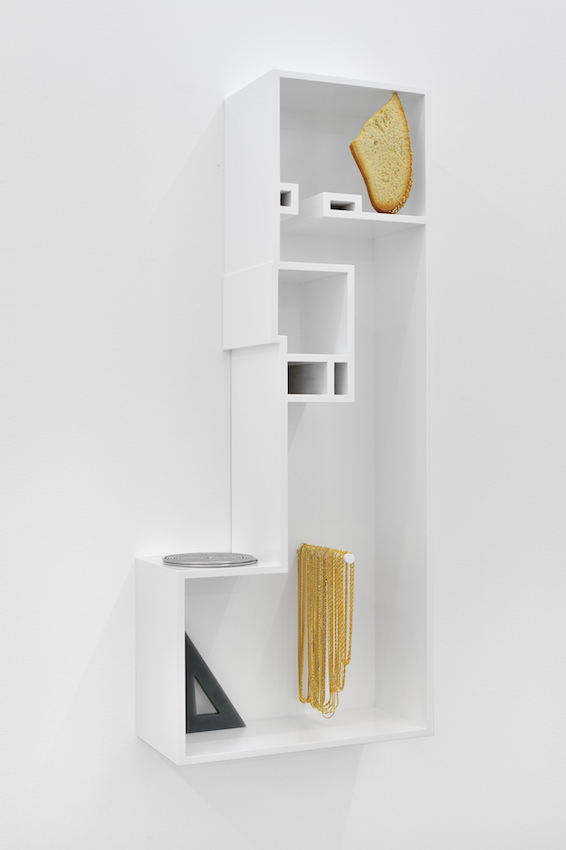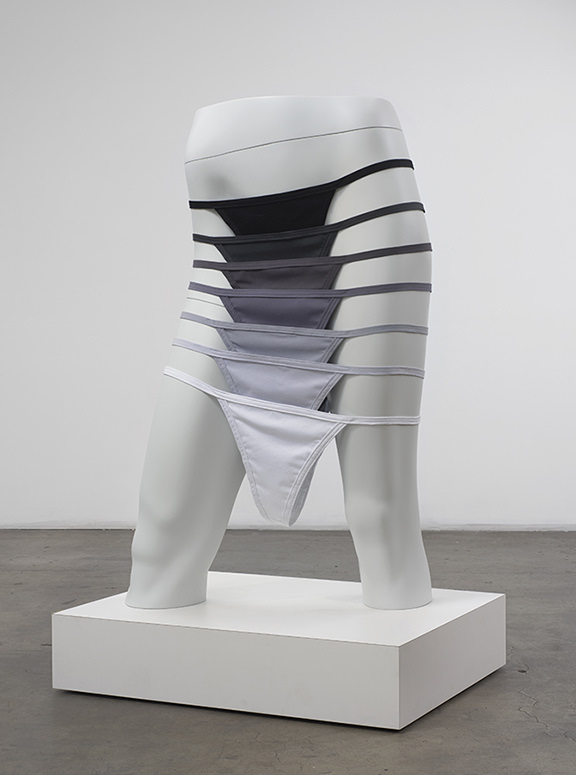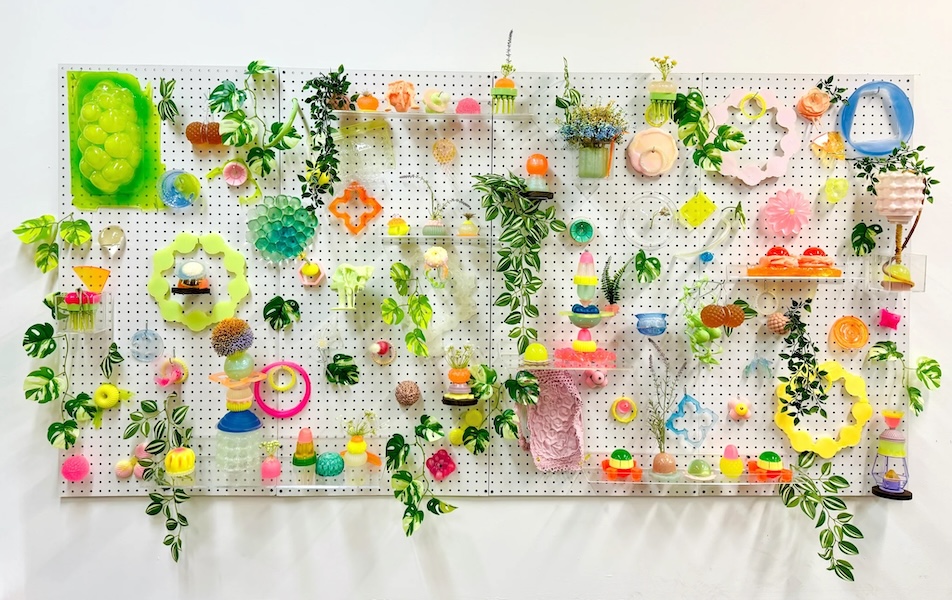Looking at work by the artist Amanda Ross-Ho can feel a bit dizzying, and that might be something she’s going for. Since she moved to L.A., her art has become a lot about her studio practice, about creating a loop of the micro and macro aimed at giving viewers a sense of vertigo that makes them want to look closer, hyper-aware of their surroundings. Ross-Ho uses shifts in scale or material to jar us awake. Whitewall spoke with the artist—whose work is currently on view in group shows at the Walker Art Center and the Los Angeles Nomadic Division exhibition in Paris, “Wasteland”—about mining the intimacy of her studio.
WHITEWALL: Your work is currently on view at the Walker Art Center in Minneapolis, in the exhibition “Ordinary Pictures,” up through October 9th. It’s primarily a photography exhibition, so what of your work is included, and how does it fit in?

Photo by Sebastien Micke
AMANDA ROSS-HO: I’m super-excited about it. It’s a large group show that is looking at the idea of stock photography. I’m an interesting contribution because I’m showing two sculptures. [Laughs] One is a sculpture I made originally for a survey exhibition I did here at MOCA in 2012. It’s a large-scale, highly fabricated version of the analog photo enlarger that belonged to my parents growing up. I had parents that were photographers and we had a dark room in our home. This is a mid-sixties model photo enlarger. I have worked for a long time with a Hollywood fabricator here, a collaborator at this point, and we took apart the original object, which I had as an artifact. We basically re-created every single part really fastidiously. It’s a version of that object at a very large scale. It is a very, very longhand version of understanding the anatomy of something, but also creating this monument to my early history and to an antiquated medium almost completely out of circulation.
The reason why I’m excited that this is going to be included in this exhibition is that the production of it is this close-focused, almost like a photographic process, where we are really re-creating every little piece. The scale shifts, which is consistent in my work for a long time. And this piece is, in some ways, almost a little bit poking fun at that, right? The enlarged photo enlarger. [Laughs]

Amanda Ross-Ho
WW: What is the other sculpture in that show?
ARH: The second piece is actually an artifact from the public sculpture that I made for the MCA Chicago. It will be the upscale color card piece that was included in that original presentation in Chicago. And that color card is an upscaled rendering of the color calibration card that you’d use in studio photography. I’m excited about that, too, because I like the idea that you’ll see this group of other photographs and then these objects that are support systems for making those pictures.

Untitled Model (BREAD AND TRIANGLES)
WW: And some of your work will be on view in Paris as well through the Los Angeles Nomadic Division group show, “Wasteland.” Can you tell us about that? Will that be previously shown work or new?
ARH: For some time I’ve been using the space of the studio as a source for information and material. I’m operating within this idea in various different ways. For a long time I’ve been trying in my installation work to make something that has a sense of vertigo, where you have something that is incredibly intimate and close to your body, in some ways, that then jars you into another perspective moving through installation. I had this very simple idea with a recent show in Paris [“How to Remove Dark Spots” at Praz-Delavallade]. It came out of being on a road trip and seeing this map in a diner where all these people had scribbled on it to announce where they had been. I thought, “That’s such a nice, simple way to almost literally conflate or flatten that idea of how you visualize this totality and then that immediacy of mark, that personal kind of touch.”
So I ended up getting a super-readymade world map and simply putting it in my studio. I spend a lot of time in the space, and much of the work is about my intimacy with the studio. I know what happens in there very, very intimately. I always make little notes, or draw something really fast, make a calculation, or as a nervous tick I scribble something down, and usually that accumulates in various spots, on the walls or on a random piece of paper. So this became a way to capture all of that stuff. I just let the map sit on my studio table and as I made notes, it would all accumulate on that surface.
Then, I pulled the palette from that map, all the countries were codified with color based on that map, mixed paints to match all those colors, and I made an abstraction, what I would describe as a prop painting, an extremely self-conscious amalgamation of many different styles of abstraction, like something you’d see in an Ikea. And I used these large-scale brushes to make the brushstrokes so they’d seem upscale, and everything has this hyperbolic feeling to it.
So for the LAND show I’m making a version of that and extending this a little bit more amplified; rather than a readymade map, I’m going to print a large-scale map the size of one of the drop cloths that I use on the studio floor and produce a set of paintings on top of it and allow it to accumulate a different but similar set of residue of my own activity on it.
WW: Does it come naturally for you to be so reflective within your studio? I know it’s been a part of your practice for some time, but do you have to remind yourself to be so self-aware, or is it second nature?
ARH: It’s been going on for so long it’s hard to find those origins, but I do think that it originated probably right when I moved to L.A. What happened was all of a sudden I was spending hours in the studio, and that became something that felt performative but also felt like such a shift that in a way it became the subject of the work and started the conversation about finding analogues to other things within that inquiry. It remains pertinent for such a long time that it does come naturally. I don’t have to think about that too much, although the methodology of working in the studio then becomes an interesting combination of being very, very close-focused and trying to pay attention to everything that is happening, but also having this hyper-awareness of the fact that I’m also theatricizing that and borrowing all those gestures. It’s as much performative as it is, a lot of the times, it’s the production is not necessarily productive. I’m in there as much as I physically can be in there, but I’m not necessarily making things at all times, because a lot of it is just looking.
WW: When you are out of the studio, can you turn that off?
ARH: I think when I’m out in the world I’m doing a lot of note taking through photographs and written note taking. I think it’s very hard to turn it off, which is why I have my home and work separated. It’s very hard to shut that down. For me when I’ve come home, work is done. But there is always the sensation of gathering data to introduce into the system of the studio space, which just becomes an engine, like gas or something to put into the thing that is already going.
That kind of gaze doesn’t end. I think that’s what I, on some levels, love about that—that there is an altered state that gets transported to the outside world that makes you sensitive to the nuances of a space that isn’t intended for production. That extends to wherever I am, I guess. And I like that it feels, I think on some silly level, like I’m cultivating a condition in which I have to pay very close attention to everything and I’m hyper-sensitive. And hopefully there is some symmetrical kind of experience for a viewer of the work, to promote that way of looking, because I feel as though that is a good way to move through the world.
This article is published in Whitewall‘s spring 2016 Art Issue.









